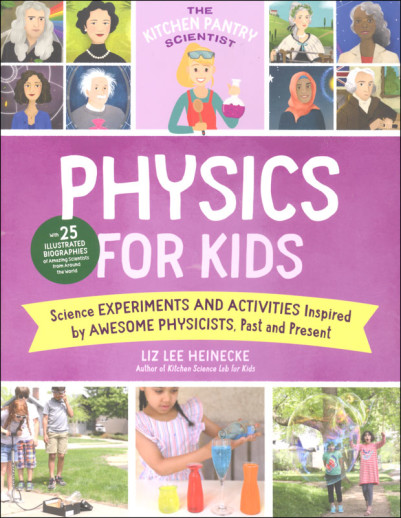We use cookies to make your experience better. To comply with the new e-Privacy directive, we need to ask for your consent to set the cookies. Learn more.
Physics for Kids (Kitchen Pantry Scientist)
Aspiring young physicists will discover an amazing group of inspiring scientists and memorable experiments in Physics for Kids, the third book of The Kitchen Pantry Scientist series.
Make a water rocket and engineer the perfect paper airplane. Play with mirror images. Use atmospheric pressure to push an egg into a bottle. Crush a mint to create a flash of light. This engaging guide offers a series of snapshots of 25 scientists famous for their work with physics, from ancient history through today. Each lab tells the illustrated story of a scientist along with some background about the importance of their work, and a description of where it is still being used or reflected in today's world.
A step-by-step experiment paired with each story offers kids a hands-on opportunity for exploring concepts the scientists pursued, or are working on today. Experiments range from very simple projects using materials you probably already have on hand, to more complicated ones that may require a few inexpensive items you can purchase online. Just a few of the incredible people and scientific concepts you'll explore: Galileo (b. 1564) Play with pendulums. Sir Isaac Newton (b. 1642) Center of gravity balancing trick. Albert Einstein (b. 1879) Playground ball relativity. Stephen Hawking (b. 1942) Collapsing stars and black holes. Christine Darden (b. 1942) Engineer a perfect paper airplane.
With this fascinating, hands-on exploration of the history of physics, inspire the next generation of great scientists.
This resource will show you that you CAN introduce science to little kids and it CAN be easy and fun! The Chemistry for Kids lessons include the history of an inventor and a lab related to their work. For example, in lab #7 you read about William Henry Perkin and his work with synthetic dyes in 1838. He entered college at only 15 years old! He discovered a purple dye by accident and followed up. When he was 18, he applied and was awarded a patent for mauve dye which became the height of fashion. Your activity to emulate his work involves wool yarn, white vinegar, and food coloring of some sort. There are 25 labs in each book. If you are looking for a casual science option for this age group, I think kids and parents will enjoy this series. It feels like something you could do once a week. Not consumable. ~Sara
| Product Format: | Paperback |
|---|---|
| Brand: | Quarry Books |
| Author: | Liz Lee Heinecke |
| Grades: | 3-6 |
| ISBN: | 9780760372432 |
| Length in Inches: | 11 |
| Width in Inches: | 8.5 |
| Height in Inches: | 0.375 |
| Weight in Pounds: | 1.1 |

